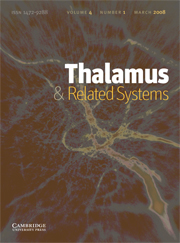Article contents
Dichronous appearance and unusual origins of GABA neurons during development of the mammalian thalamus
Published online by Cambridge University Press: 12 April 2006
Abstract
These studies in fetal monkeys and ferrets show that the two fundamental types of thalamic GABA neuron populate the thalamus during widely separated developmental epochs. Those of the ventral thalamus (VT) and epithalamus (ET) appear very early in conjunction with the GABA cells of the substantia nigra, globus pallidus, and pretectum (PT). GABA neurons intrinsic to the dorsal thalamus (DT) appear later, long after proliferative activity has ceased in the wall of the third ventricle, after dorsal thalamic nuclei have differentiated and at the same time as principal neurons are acquiring a glutamatergic phenotype. The exact origins of the two waves of GABA cells are uncertain but some appear to arrive from extrinsic sources that include the ganglionic eminence (GE) of the basal forebrain.
Keywords
- Type
- Brief Report
- Information
- Copyright
- 2002 Elsevier Science Ltd
- 5
- Cited by


